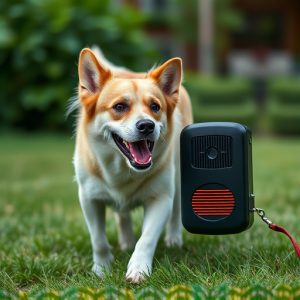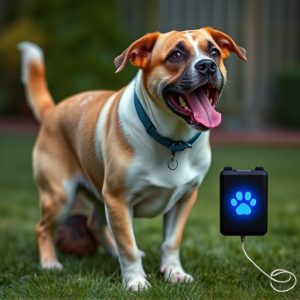Mastering Portable Dog Training Ultrasonic Equipment: A Comprehensive Installation and Use Guide
Portable dog training ultrasonic equipment safely corrects unwanted behaviors by emitting inaudible…….
Portable dog training ultrasonic equipment safely corrects unwanted behaviors by emitting inaudible high-frequency sounds to dogs. Selection should consider breed and size, with adjustable sound levels and range. Installation requires strategic placement, careful unboxing, assembly following manufacturer instructions, and testing. Effective use involves understanding canine behavior, adjusting settings, and consistent positive reinforcement during training sessions guided by professionals and the Portable Dog Deterrent Installation Guide.
“Unleash a well-behaved canine companion with the power of portable dog training ultrasonic equipment. This innovative technology offers a humane and effective way to teach your pet basic commands and curb unwanted behaviors. In this comprehensive guide, we’ll explore the inner workings of these devices, helping you choose the perfect fit for your dog’s needs. From installation to training tips, discover how to harness the benefits of portable dog deterrents and transform your pet’s behavior with ease.”
- Understanding Portable Dog Training Ultrasonic Equipment
- Choosing the Right Device for Your Dog's Needs
- Installation and Set-up: A Step-by-Step Guide
- Effective Use and Training Tips
Understanding Portable Dog Training Ultrasonic Equipment
Portable dog training ultrasonic equipment, often referred to as portable dog deterrents, is a game-changer for pet owners looking to train their dogs in various settings. This innovative tool uses high-frequency sound waves to communicate with dogs, providing a safe and effective way to correct unwanted behaviors without the use of shock or force. Understanding how this equipment works is crucial for its successful installation and use as a portable dog deterrent.
A typical portable dog training ultrasonic device emits sounds that are inaudible to humans but can be heard by canines. When a dog displays undesirable behavior, such as barking excessively or jumping on furniture, the owner activates the device. The high-frequency sound waves are then projected into the dog’s range of hearing, creating an unpleasant sensation that reinforces the need to stop the behavior. It’s important to note that this method is not harmful to dogs; it simply utilizes a different form of communication to teach and train them effectively. Following a portable dog deterrent installation guide ensures that you set up and use the equipment correctly for optimal results.
Choosing the Right Device for Your Dog's Needs
When selecting a portable dog training ultrasonic equipment, understanding your dog’s specific needs is key. These devices use high-frequency sound waves to deter unwanted behaviors, making them ideal for addressing issues like barking, jumping, or running off. However, not all models are created equal. For smaller breeds or puppies with more delicate hearing, investing in a lower frequency device is crucial to avoid discomfort. A well-researched purchase should consider factors such as adjustable sound levels and range, ensuring the equipment can be tailored to your dog’s unique requirements.
A comprehensive portable dog deterrent installation guide will walk you through setting up the device effectively. This includes choosing an appropriate location – often outdoors – where the ultrasonic waves can reach without interference. Proper placement is essential for maximizing effectiveness while minimizing the impact on other pets or humans in the vicinity. Regular testing and calibration, as recommended by the manufacturer, will also ensure the device functions optimally over time.
Installation and Set-up: A Step-by-Step Guide
Setting up a portable dog deterrent system is straightforward with the right approach. Begin by selecting a suitable location for the device, ensuring it’s in a strategic spot where your pet tends to exhibit unwanted behavior. This could be near gates, doors, or areas they frequently access. Next, carefully unpackage the equipment and familiarize yourself with its components: a control unit, an ultrasonic transducer, and possibly a battery pack.
Follow the manufacturer’s instructions for assembly. Typically, this involves connecting the transducer to the control unit using provided cables. Ensure all connections are secure. Once assembled, place the device on a stable surface or mount it according to the product guidelines. Testing is crucial; follow the installation guide to activate and adjust the settings, ensuring it emits the ultrasonic sound effectively without causing harm or discomfort to your pet.
Effective Use and Training Tips
Using a portable dog deterrent equipment effectively involves understanding your pet’s behavior and adjusting the settings accordingly. Start by consulting with a professional trainer or behaviorist to identify specific triggers and desired outcomes. Place the device in areas where unwanted behaviors occur, such as entry points into your home or yard, and activate it during training sessions. Gradually increase the sensitivity level as your dog learns to respond to commands.
Training tips include consistency, patience, and positive reinforcement. Set regular training sessions, use clear and consistent commands, and reward good behavior immediately with treats or praise. Avoid using the device as a punishment; instead, focus on encouraging desired behaviors. Remember, the goal is to teach your dog alternative behaviors, not simply deter them from unwanted actions. Always follow the manufacturer’s guidelines for safe and effective use of the portable dog deterrent installation guide.
Portable dog training ultrasonic equipment offers a convenient and effective solution for managing unwanted behaviors. By understanding how these devices work and choosing the right model for your dog’s unique needs, you can successfully implement this non-invasive method. Following our comprehensive installation guide and leveraging helpful training tips ensures effective use, leading to positive results in no time. Remember, consistent application and patience are key when using any deterrent system.


